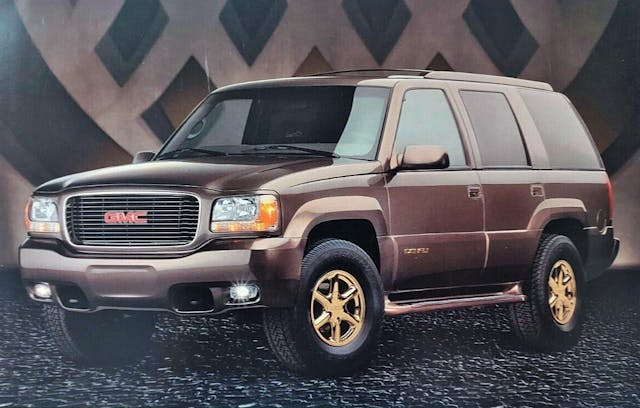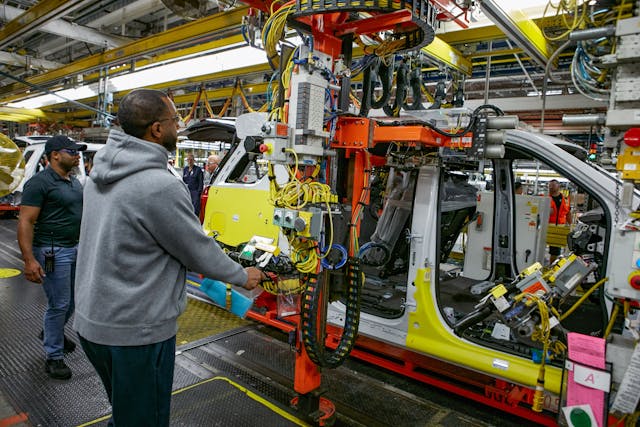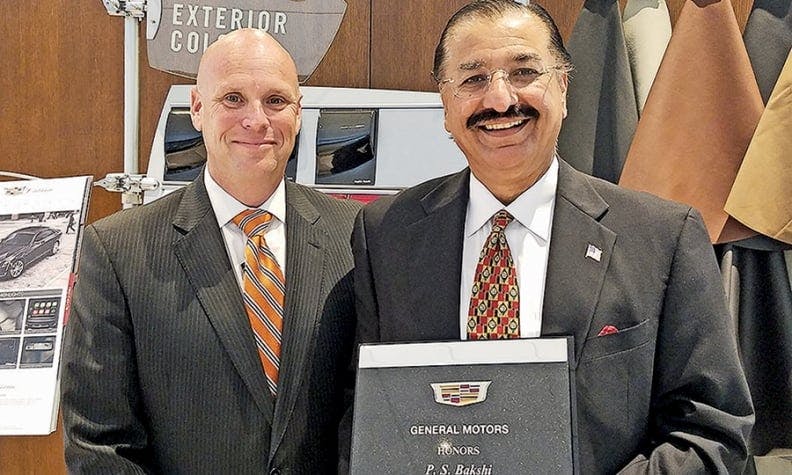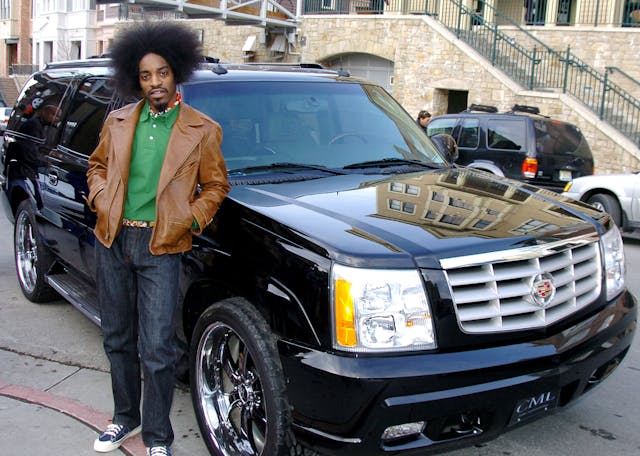Media | Articles
Actually, Cadillac’s First Escalade Was a Smashing Success
I recently assessed the impact of the 1999 Cadillac Escalade after 25 years on the road. That lookback proved the original Escalade started something special in automotive history—even with its badge-engineered warts, which were present for all to see.
(For those who may be unfamiliar with the term, badge engineering is when a manufacturer re-uses the same customer-facing parts for multiple vehicles across different brands, essentially doing little else but swapping a badge. Manufacturers love badge engineering because it saves them time and money. Automotive enthusiasts hate it because it corrodes the uniqueness of the brand(s) they admire.)
Contrary to popular belief, those faults did not hinder the Escalade from reaching automotive stardom or keep it from matching the sales volume of the already famous 1998 Lincoln Navigator. In fact, the parts interchange problem almost had a negligible effect in those early days of the luxury SUV market. The tepid sales of the original Escalade came from an unexpected source, as you shall see as we dig deeper into the story of the first Escalade on this icon’s silver anniversary.
A Near-Instant Success

Raymond Schmit and Cadillac go together like peanut butter and jelly, and it all started in 1985 when he was a field representative for the brand. Cadillac always had a small marketing team dedicated to each model in its portfolio, and Schmit was fortunate to be the marketing manager on the team tasked with promoting the 1999 Escalade.
Schmit was in a unique position in General Motors’ history: He was releasing a product that had never existed before in the Cadillac portfolio. The same can be said of flops like the Catera or Cimarron, both Cadillac models that entered a market filled with established players around the globe. The key differentiator is that Schmit introduced a vehicle with a strong precedent for success in a uniquely American market, albeit with internal (GMC Yukon Denali) or external competition (Lincoln Navigator) that already proved the business model.
Marketplace
Buy and sell classics with confidence


But neither the GMC nor the Ford had the long-standing prestige and/or sales success of the Cadillac brand. Schmit says his team always believed the 1999 Escalade would be a success. Closer to its official launch, they all knew it. There was no concern over how the Escalade would be received, only over how many units Cadillac could provide to dealerships. Lincoln’s Navigator SUV rolled off the assembly line on July 1, 1997. Lincoln’s pipeline was eager to supply a hot new market, one akin to the burgeoning pony car market decades before. Therefore, Schmit’s assertion that his team “wanted Escalade production quickly, and with as many units as possible” is absolutely believable.
Badge Engineering, Smadge Engineering

I asked Schmit when the 1999 Escalade’s business model proved itself. I also asked about those badge engineering concerns that we enthusiasts reference in knee-jerk fashion. His main concern wasn’t having a Cadillac that resembled a Denali; instead, he reiterated the need to get Cadillac’s “share of manufacturing from GM.” (As we’ve previously noted, it’s often a waste of time to serve the enthusiast market.)
Lincoln only had to wrangle Navigator production from a single Ford product (Expedition), but Schmit wrestled with both of GM’s established truck brands (GMC, Chevrolet) and with their four SUVs (Tahoe, Yukon, and a Suburban for both) that were already flying off their respective showroom floors. Schmit bluntly recalled it was “a battle to see how many Escalades they could get” from General Motors’ assembly plant in Arlington, Texas.

Schmit offered another unexpected nugget of wisdom about the 1999 Escalade: Cadillac’s official marketing problem for the big SUV actually started two years earlier in 1997. Deliveries began in 1998, with a modest 3089 units sold that year. By 1999, they shifted a full 23,987 units, but Schmit firmly believes sales could have been higher had Cadillac secured the aforementioned extra volume.
Consider the fact that GMC sold 12,862 Denalis in 1999. Combining the two makes for a theoretical 36,849 units of Cadillac’s SUV. That’s within spitting distance of sales for the 1999 Lincoln Navigator (39,250 units), showing just how close Schmit was to making the Escalade the presumed leader in the early days of the luxury SUV.
A Foot in the Door

Schmit and his team knew they had a winner on their hands. But they openly admitted that the first Escalade existed to give Cadillac “a foot in the door” of the luxury SUV genre. This was an all-new market, and their team didn’t assume the Escalade could reach the market share it enjoys in modern history, because “it was zero back in 1999.” The initial success of the Escalade was akin to a home run, one that turned into a grand slam as production increased to satisfy demand and as Schmit realized how many influencers and tastemakers wanted one.
Schmit says that it is now “hard to imagine Cadillac without the Escalade.” What Schmit found especially unique was how quickly the Escalade surfaced around the world, becoming a preferred method of transport for Premier League footballers in England. It has staying power, too; the American SUV is still a baller’s best friend.
To say the 1999 Escalade was a success is an understatement, and Schmit noted that everyone who participated in the Escalade program was “glad to be a part of it.” He believes this vehicle alone ensured that the Cadillac brand moved in a new trajectory. And it progressed rapidly in that direction. Schmit says that his experiences launching the 2002 redesign of the Escalade, the extended length ESV, and the EXT truck all happened “at 110 miles per hour.”
Schmit, a man who dedicated many years of his career to the support of Cadillac dealers, noted that dealers around the country were thrilled with the 1999 Escalade. And that is when Schmit and I realized we had a mutual acquaintance, one that I decided to give a ring for this story.
Delighted Dealers Across the Land

Meet Bob Bakshi, founder of Parkway Cadillac in Valencia, California. His engineering background includes work for automotive/aerospace corporation TRW, but he never quite fit the corporate mold. So he jumped at the chance to open his own Cadillac franchise back in 1991, and his dealer list blossomed to other makes in the following decades. While he sold off those later acquisitions over time, his Buick/GMC/Cadillac is his pride and joy. It’s also a rarity in modern times, when so many retailers are owned by soulless Fortune 500 corporations.
Bakshi is a man after my own heart, but that’s because he’s also my uncle.

My interview with “Uncle Bob” admittedly included more time spent on personal updates than on professional discussions about the 1999 Escalade, but he knows exactly how important the original Escalade was to the Cadillac brand. We got to that after discussing our shared love of Northstar-powered Allantés.
The word “game changer” was mentioned several times. Uncle Bob said the Escalade was an instant hit in the Los Angeles area. He reminded me of a discussion we had back in the late 1990s, when he shared how difficult it was for his dealership to get Escalade (and Yukon) inventory from GM. He somewhat jokingly remarked that Texans (like yours truly) were hogging up all the SUVs that he so desperately wanted to sell in L.A.
It’s hard to imagine a time when SUVs weren’t dominant figures on the American landscape, and not just in places like truck-heavy Texas. But Uncle Bob said the Escalade “ignited Cadillac vehicle sales” and that even today concedes “it is the most desirable Cadillac!”
Universal Appeal, Younger Demographics

Juanita Slappy, Cadillac’s head of multicultural marketing, has a strong passion for and a storied legacy with the Cadillac brand. Though her marketing expertise has led her to jobs with all of the Detroit Big Three, she has been with GM for seven years, and in her current position with Cadillac for three. Her bonafides include her grandfather, who worked for the brand, and the car she learned to drive on: a 1989 Seville. She still has keys to that Seville and a Cadillac STS in her possession, but now they are keepsakes of automotive jewelry. Slappy embodies the passing of Cadillac keys across generations, a sign of generational wealth transfer, and the act of love and adoration within a family.
Cadillac has embraced this notion since the beginning of the Escalade’s popularity in the early 2000s. As then-spokesperson Susan Docherty remarked, “I’m surprised by the number of younger buyers that are attracted to the Escalade.” Most brands hope to achieve such a monumental shift in demographics over time, but few achieve it with the resounding success of Cadillac and the Escalade. Docherty added: “The world is not about what older people think; it’s about what younger people do.”
For Juanita Slappy, early 2000s pop culture provided tremendous inspiration for her current role with Cadillac. While earlier Caddys got a publicity bump from the likes of Chuck Berry and Elvis, Southern hip-hop artists embraced the Escalade early on, most notably the Big Tymers in 2000. The big SUV’s mainstream moment in the sun likely came from sensations like Jay-Z and Jennifer Lopez, leading to broad cultural acceptance across the country. This is best seen when Mike Meyers referenced the luxurious icon in an Austin Powers movie back in 2002.



Let’s get back to the connection between the original Escalade and the Southern hip-hop scene. Seven-time Grammy Award winner Big Boi, part of the rap duo OutKast, found inspiration in Cadillacs for his musical creations on numerous occasions—his references to a “canary yellow” 1979 Seville are likely the most recognizable. The connection goes deeper, as OutKast’s first album had the word Cadillac in the name, and their logo is based on the brand’s famous crest design.
So it’s only natural that Cadillac asked Big Boi to create a clever rap about the upcoming, battery-powered Escalade IQ. It’s a natural pairing of pop culture two icons from the last 25 years and shows the staying power of both over time.
Escalading to Cadillacs and Coffee




Cadillacs are more than luxury cars, with a legacy that goes far deeper than off-lease BMWs or drab creations from Lexus’ pursuit of perfection. People across the country covet Cadillacs, whether they take the form of high performance V-Series monsters, California-style low riders or kustoms, Dirty South donks, Houston slabs, or concours-worthy time pieces dating from the 1930s.
These disparate groups of vehicles seemingly have nothing in common except the Cadillac badge. Except not, because Houston’s burgeoning Cadillacs and Coffee scene welcomes all Cadillac fans. It even let an automotive journalist with a 2024 Escalade Platinum press vehicle join its ranks.



I reached out to the founder of Cadillacs and Coffee Houston via its Instagram, and met founder Jorge “Drastiko Rawdriguez.” He started the group in 2022, and watched the gatherings grow from 5 to 45 or 50 vehicles. Drastiko’s Saturday morning events are a pop-up for local businesses, and the beautiful Caddies draw foot traffic everywhere they park.
His mission is to be a community partner, to create “a car community with purpose.” Cadillacs and Coffee has helped the city of Houston with toy drives, networking events, and anything that helps “lift each other up.” Rawdriguez proudly notes his Cadillac DeVille is one of the last examples with the proven 4.9-liter V-8. The car was his inspiration to create Cadillacs and Coffee for the city he so adores. His generosity runs deep, right down to the free, Cadillac-themed cookies offered to participants.


Drastiko has loved the Escalade ever since he saw one with bigger, aftermarket wheels as a kid. For him the Escalade was both a dream car and a practical reality, as it was a “big body” vehicle like traditional Cadillacs and utilitarian enough to haul a family. While other luxury automakers make SUVs, Drastiko insists that Cadillacs feel different behind the wheel—and those good feelings have no peer.




I asked a few of the show’s participants similar questions, starting with “EZ” Martinez, who brought a triple-black, stainless steel Eldorado Biarritz in museum-quality condition. He confirmed my notion that the Escalade arrived on the map after the Big Tymers put it in music videos: They “made it a status symbol.”
Chelsea and her customized 1968 Coupe DeVille fit the modern mold of kustom kulture, but her daily driver is a 2016 Escalade ESV. She loves her Escalade because it’s the only way to feel the luxury of a Cadillac and turn the heads of a diverse range of fans, all while hauling a family. Alex, with his 2019 CTS on airbags, reiterates the need for a big-body Cadillac: He loves SUVs, especially those that are a cut above a GMC Denali or Chevrolet Suburban.

Then we have Josh Carpenter, a North Carolina resident who visited Cadillacs and Coffee as part of a 6000-mile trip to Las Vegas in his custom Sedan DeVille. Perhaps that 75-hour journey is worth more than a mere mention, but when I asked him about the Cadillac Escalade, he straight-up called it a “family ride” and credited its popularity to numerous shoutouts on MTV Cribs.
While Carpenter’s remarks may not be the strongest endorsement of the Escalade’s presence over the past 25 years, the vehicle deserves respect for opening up the brand to a new world of customers. He’s right, this is indeed a ride for families, because I took this 2024 Escalade Platinum to four events around town, and it delighted children of all ages. One such kid had never been in a vehicle with a V-8 engine, and the deep rumble of the Escalade’s exhaust excited him to the core.

Some of the goodwill should go to the Atari 2600 Plus I connected to the Escalade’s rear screens and AKG audio system. While you can pull off this feat in many modern vehicles, no vehicle shows off this retro gaming technology with the gravitas of a flagship Cadillac SUV. It proves the Escalade offers something for everyone: While a few traditional car enthusiasts balked at the Escalade’s presence at a car show, nobody questioned the thrust of its 6.2-liter mill with its rapid-fire 10-speed automatic. (Very few people had a chance of beating it in a straight line, and they knew it.)
An Enduring Legacy


Spending a week with this top-tier Caddy reminded me how automotive evolution works, and why it’s better to seek continuous improvement rather than to throw the baby out with the bath water. The 1999 Escalade may be a forgettable vehicle relative to the newer examples, but the core recipe of small-block torque and decadent utility has been the same since day one.



But what makes the Escalade continually relevant is the amount of new features added over the last 25 years. Night vision is one example, and it does a fantastic job of spotting pedestrians before the human eye can. It pairs well with General Motors’ Super Cruise system, which operates hands-free with near flawless precision and none of the pitfalls of Tesla’s FSD system. Finally, the Escalade’s augmented reality screen provides better vision for low-speed maneuvers and takes the guesswork out of determining where to turn on a multi-lane off-ramp with less-than-intuitive signage. Perhaps the Escalade is America’s S-Class?

The 2024 Escalade is still true to the 1999 template in one unfortunate way. When I took this beauty to my local mechanic (to check on one of my project cars), the owner came out, saw the Escalade’s roof from a compromised viewpoint, and candidly remarked, “Why are you driving a new Tahoe?” When I told him it was actually an Escalade, he was intrigued and excited: No badge engineering concerns what-so-ever, just like Escalades from 1999.
Perhaps Cadillac could do better. Just look at the current Dodge Durango and fourth-generation Jeep Grand Cherokee, which similar bodies but radically different pillar designs. But those Chevrolet roots ensure this top-tier luxo-tech wagon has staying power, giving the Escalade a foundation that’s durable and affordable to repair decades after the warranty expires. Here, the Cadillac excels where Land Rovers and most any SUV from Germany fails. (I reckon even a Lexus SUV costs more to repair than an Escalade when the same item fails.)

The 1999 Escalade was not first to market, and it’s a shame that supply couldn’t initially meet demand, but there’s good reason why this Cadillac has been the luxury SUV tastemaker for a quarter century. Like many an American success story, the Escalade hit the ground running and never looked back. Here’s to 25 more years of the Escalade earning the name of Cadillac.
***
Check out the Hagerty Media homepage so you don’t miss a single story, or better yet, bookmark it. To get our best stories delivered right to your inbox, subscribe to our newsletters.

















































Arlington, Virginia? I’m hoping there’s some Notherner editor we can blame this on.
Blame it on me for not specifying in the first place. People from Houston are bad about giving DFW the credit they deserve for anything. 🙂
You do a great job on long-form journalism. Kudos to Hagerty for giving you the space.
And kudos to you for the kudos. I am glad you enjoyed this journey of mine.
I was doing IT work at a Cadillac dealer around the time the Escalade started. I still remember people dumping thousands of dollars for big wheels on rubberband tires after dumping their Corvette or Viper for one of these things. While I’ll never understand that behavior it is easy to say that the Escalade has been Cadillac’s bigest modern success.
I’d still rather have a V-Series/Blackwing sedan myself.
I was a salesman between jobs in 2000. I sold the first Escalades at our dealership. They were popular with our Bronco football players, then Rockies Baseball players. I sold 6 in no time. Black was the favorite color. Of course special, wheels, dark tint, video players and upgraded sound systems.
We received a black one with a supercharger, upgraded suspension, I think headers and special exhaust system. It was fast. I believe it was factory, but we did not receive another. Anyone know anything about the this special Escalade? I sold it within two days
Definitely not factory, sounds awesome though. Cadillac didn’t have the time to federalize a supercharger for production. Even if they did, would GM and the Arlington plant stop long enough for that change? Plenty of folks were tuning GMT-400 trucks back then and could easily do all that to an Escalade, and that’s more likely.
Thanks. Wish I could trace it. Be great to get more history.
The XLR, CTS-V, their variants, and the Blackwing duo are the stuff of dreams. It is a shame Cadillac could not have been spun off from GM, gone private, and kept on making amazing niche automobiles.
The old joke about Cadillac still applies. The only ones who don’t know they’re out of business are Cadillac themselves. Anything else is a better choice.
Let’s not forget the dark side of the escalade. It’s THE vehicle of choice for gang bangers and other criminals. Might have something to do with rappers bragging about their “conquests”.
Loved the 2003 ESV our Saturn dealership brought in back in 2004. It had the Oyster-coloured leather and was that popular metallic brown of the day on the outside. Gorgeous vehicle!
Very good friend had a 1993 STS, 2004 DTS and a 2015 CT6 – when the ‘large’ Cadillac cars disappeared, and he didn’t want an Escalade (even though his is 6’2″), he bought a G90 Genisis; lovely car, but really meant for chauffeur operation, the back is roomier than the front!
When looking at our most recent purchase, I couldn’t find enough difference between the Buick Envision and CT5 to justify the extra expense, so we now have a Buick, which we are delighted with. Maybe for our next vehicle…
Great piece, Sajeev!
Thank you! Glad you enjoyed it, and I hope the Envision treats you well!